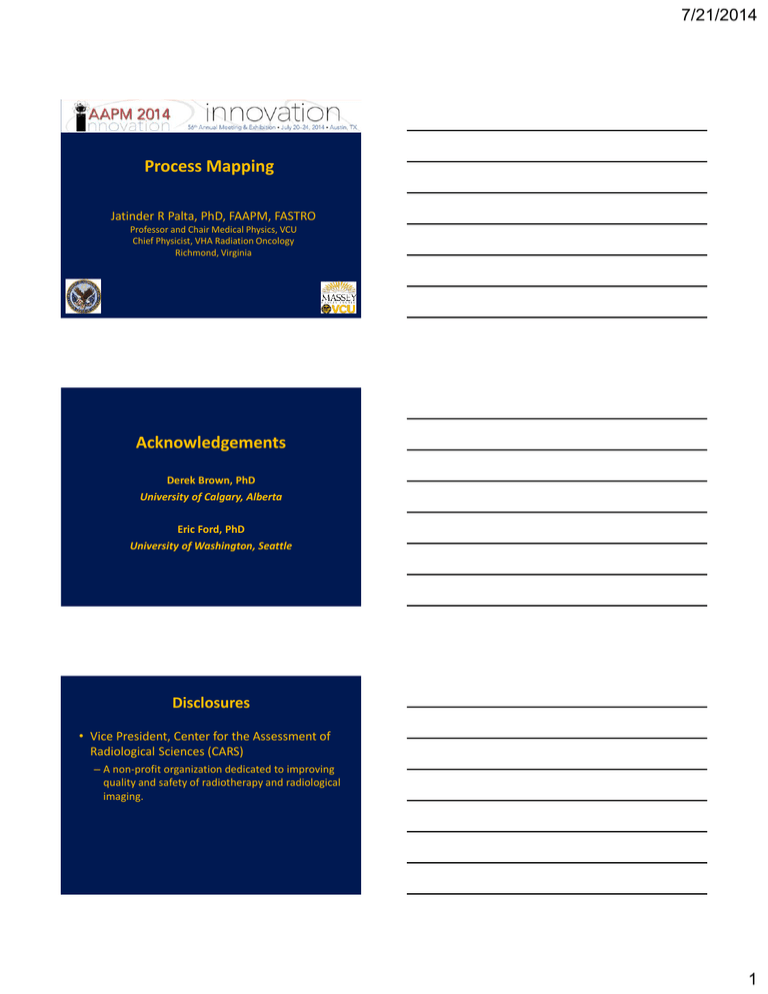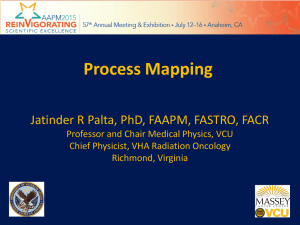Process Mapping Acknowledgements 7/21/2014 Disclosures
advertisement

7/21/2014 Process Mapping Jatinder R Palta, PhD, FAAPM, FASTRO Professor and Chair Medical Physics, VCU Chief Physicist, VHA Radiation Oncology Richmond, Virginia Acknowledgements Derek Brown, PhD University of Calgary, Alberta Eric Ford, PhD University of Washington, Seattle Disclosures • Vice President, Center for the Assessment of Radiological Sciences (CARS) – A non-profit organization dedicated to improving quality and safety of radiotherapy and radiological imaging. 1 7/21/2014 Learning Objectives • To understand why process maps are useful in the clinical environment. • To become familiar with a few examples of process maps. • To discuss several important tips for creating useful process maps. What is a Process? • A process is a series of steps or actions performed to achieve a specific purpose. – process has inputs and outputs • A process can describe the way things get done. All clinical workflows involve many processes. What is a Process Map? • A pictorial representation of the sequence of actions that comprise a process. 2 7/21/2014 Process Maps are used to • Document processes. – Provide a reference to discuss how things should be done – Describe and understand the clinical workflow • Analyze and improve on processes. – Identify areas of complexity and ambiguity – Identify failure modes and areas of re-work – To generate ideas for safety barriers – Illustrate process improvements Why is Process Mapping Important? • It provides an opportunity to learn, standardize, and improve clinical processes – Clinical processes if not clearly documented can be ambiguous and subject to multiple interpretations “You don’t learn to Process Map, you Process Map to learn”. Myron Tribus Quote Process Maps – Why Bother? Greg Marsha • Greg is an experienced therapist – Linac 1 • Marsha is a seasoned veteran therapist – Linac 2 3 7/21/2014 Process Maps – Why Bother? Patient enters treatment room … … Patient setup … … Beam on Process Maps – Why Bother? Linac 1 – Patient Setup Procedure Ready to Treat Process Maps – Why Bother? Linac 2 – Patient Setup Procedure Ready to Treat 4 7/21/2014 Process Maps – Why Bother? Patient enters treatment room … … … Marsha is called away to answer an urgent question from a relative of another patient … Beam on Process Maps – Why Bother? • Marsha returns within a few minutes and asks Greg if the patient has been setup correctly • Greg, always glad to have done the job right, answers yes enthusiastically… Process Maps – Why Bother? 5 7/21/2014 What are the Benefits? • Immediate benefits – Improving communication – everyone is on the same page! – Harmonizing clinical practice and ensuring that everyone operates with a shared model. – Improving efficiency. Workflow inefficiencies can become obvious when mapped out visually Preparing to Process Map • • • • • • • Assemble the Team. Agree on which process you wish to process map. Agree on the purpose of the process. Agree on beginning and ending points. Agree on level of detail to be displayed. Start by preparing a narrative outline of steps. Identify other people who should be involved in the process map creation, or asked for input, or to review drafts as they are prepared. Important Points • Process Map what is, not what you would like the process to be. • Process Mapping is dynamic. Use Postit notes, dry erase markers, pencil, etc. • All Process Maps must have start and stop points. 6 7/21/2014 “Fishbone”Design Diagram • Each major step is a baugh on the tree • Sub-steps are branches, and then twigs, etc. Consult Planning Imaging Radiotherapy Treatment Simulation Plan checks Treat Ishikawa Diagram • Looks like a process map, but… • General use is as a cause-effect tool • Can be used to show the variables that go into a process Equipment Process Staff Radiotherapy Treatment EFFECT Manuals Environment Management CAUSE Kaoru Ishikawa, 1960’s, Mitsubishi Motors Types of Process Map Process flow diagrams Frank Gilbreth, 1920’s, ASME 7 7/21/2014 Symbols Used to Process Map start / end document decision Y flow arrow activity N database Start & End: An oval is used to show the materials, information or action (inputs) to start the process or to show the results at the end (output) of the process. Activity: A box or rectangle is used to show a task or activity performed in the process. Although multiple arrows may come into each box, usually only one arrow leaves each box. Decision: A diamond shows those points in the process where a yes/no question is being asked or a decision is required. Process Maps: Applications • Failure Mode and Effects Analysis (FMEA) – Assemble team – Create process map – Identify failure modes Process maps – Score each for severity, occurrence and detectability Process Maps - Examples Patient Registration Physician Consultation Simulation Treatment Planning Treatment Delivery Patient Follow Up 8 7/21/2014 Process Maps - Examples Ford EC et. al , Med. Phys. 39 (12), 2012 “Consensus recommendations for incident learning database structures in radiation oncology” Process Maps - Examples Process Map for IMRT (TG 100 Example) 8 Treatment planning Specify ROI for optimization 19 10 Plan preparation Enter prescription And planning constraints 18, 21, 45 2 Immobilization and positioning 4 Other imaging Setup fields 6 Initial treatment planning directive Specify images for target/structure delineation 11 Patient informed Of imaging requirements Immobilization equipment documented, labeled, and stored Imaging and diagnosis Pt prep 35 Positioning Pt changes noted 42 Optimization/ Dose calculation 12, 31 Order fields Imaging Prepare paper chart Treatment accessories 24 Optimization settings 45 Prepare electronic chart 15 Optimization ROI 33, 44 Special Instructions (pacemakers, allergies, preps, etc.) 9 Images Interpreted 1 Patient information Heterogeneity correction 30 Specify registration goals 23, 38 Suggest initial guidelines for treatment parameters Make images Review of patient medical history Scheduling Define localization imaging Annotate localization anatomy Indicate motion/uncertainty Management 13, 14 Position patient 12 Subsequent treatments Delivery protocols Prepare DRR and other images Calculate dose to optimization points and dose distribution 12, 31 Specify protocol for delineating target and structures 17 Immobilization equipment fabricated Enter demographics Specify treatment course Setup dose calc parameters Motion Management 8 Treatment 3 Check version of plan and patient ID Automatic data entry and plan modification Run leaf sequencer Transfer patient data to treatment delivery 15 Evaluate leaf sequencer Specify dose limits and goals 26 Evaluate delivery system limitations Changes noted 32, 34 Changes correct 40, 42 Manual data entry and plan modification 39 Tx Unit operation and calibration 3 Scheduling Monitor Pt/Tx 37, 43 Evaluate plan 10, 28 Account for previous treatments or chemotherapy 4 Documentation Successful treatment Save patient Patient Position Recorded in database Data into electronic Database 22 Data into written chart 22 Information on Previous or concomitant treatment 22 Immobilization equipment documented, labeled, and stored 1 Patient database information entered Transfer CT Dataset 41 Delineate ROIs and planning structures Monitor Pt/Tx 37, 43 PTV construction Specify PTV Margin 9 Plan approval Tx Unit operation and calibration 3 Chart filing Motion management 8 Boolean operations 29, 46 MD: delineate GTV/CTV 2,5 Protocol for delineation of targets 17 Import and fuse images 16 Treatment accessories 24 Treatment settings Imaging (port films, CBCT, etc) 27 Set up data documented Patient Identified Documentation Treatment 3 Protocol for PTV Margin 6 5 Transfer images Patient prepped (contrast, tattoos, BBs etc.) 3 CT simulation Approve plan 7, 20 Edit density map for artifacts Immobilization for Imaging study Immobilization equipment fabricated Complete formal prescription 36 4D representation Transfer Other datasets Imaging Studies Select Images 25 4D imaging correct 13 Create case Positioning Patient information 35 7 RTP anatomy contouring Time out Patient ID Treatment Site 11 Initial treatment Treatment settings 9 7/21/2014 Process Maps - Examples TG-100 IMRT Process Tree Process Maps - Examples Ford et al. Int J Rad Onc Biol Phys 74 (2009) 852 - 858 CONSULT SIMULATION High-RPN failure modes TREATMENT PLANNING TREATMENT Ford et al. Int J Rad Onc Biol Phys 74 (2009) 852 - 858 10 7/21/2014 The Rough Guide • Step 1: Decide what process to map. The scale of the process is an important concern here. Don’t bite off more than you can chew! • Step 2: Form a group and identify a team leader. It is vital that all professional groups are represented in this process. This may include administrators and managers as well as clinical staff. • Step 3: Create an initial process map. It is often useful to make a first draft that does not attempt to capture the entire process in detail but rather the workflow at a more general level. • Step 4: Iterative mapping. The process map is refined with the input of all staff involved. • Step 5: Check with external resources to make sure that no steps have been missed. • Step 6: Use the process map to perform FMEA. Useful, Usable Maps and Diagrams • What’s important in designing process maps? 1. In our business it is customary to look at processes from the patient’s perspective 2. For clinical processes a multidisciplinary team is necessary for the development of a valid map 3. The number of sub-processes identified should be the smallest number to meet the objective Useful, Usable Maps and Diagrams • What’s important in designing process maps? 4. The users of the map should have the same understanding of the meaning of the subprocesses. 5. Choose the right level of detail. A map that is too general loses its utility, while one that is too detailed becomes unmanageable and staff lose the big picture. 6. Don’t get hung up on fancy graphics. There is value in the process of creating the map. 11 7/21/2014 Closing Thoughts • Brainstorming and Affinity Diagrams can be used to identify processes you wish to Process Map. • There is no single right way to Process Map. It is a tool to standardize clinical workflow to minimize mistakes • Process Maps can be used in a variety of settings outside Quality Improvement, such as: - Orienting new employees - In-service presentations - Brainstorming possible process changes - Creating or revising policies and procedures that support the process - Creating measures - Identifying logical outcomes of a process 12







